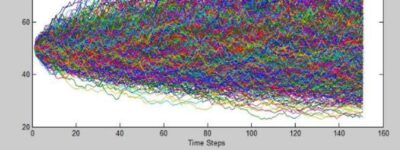Computational Physics
Transport Monte Carlo
In modern physics, we are interested in systems with many degrees of freedom. Let us consider, for example, the number of atoms in a solid, the number of electrons in an atom, or the number of electrons of a beam interacting with the many atoms and electrons of a solid. The interaction of an electron beam with a solid target has often been investigated by using the so-called Transport Monte Carlo method, a numerical procedure involving random numbers to solve mathematical problems. The simulation of the involved physical processes, by random sampling, allows solving many particle transport problems. Letting the particles carry out an artificial, random walk—taking into account the effect of the single collisions—it is possible to accurately evaluate the diffusion process. The probabilistic laws of the interaction of an individual electron with the atoms constituting the target are well known. Consequently, it is possible to compute the macroscopic characteristics of interaction processes by simulating a large number of real trajectories, and then averaging them.
We study the probabilistic laws of the interaction of individual electrons with atoms (elastic and inelastic cross-sections) and investigate selected aspects of electron interaction with matter.
In particular, we are interested in simulating the energy distribution of the electrons emerging—due to the impact with electron and positron beams—from metals, semiconductors and dielectric materials. We can simulate the whole spectrum (secondary electrons, plasmon losses, Auger electrons, reflected electrons). We are also interested in the simulation of the radial dose deposited by secondary electrons along the track of fast proton and ion beams penetrating in liquid water, polymers, and oxides, and in the average cluster size and cluster size distribution of damaging events in sensitive volumes of liquid water with dimension of DNA.
Many-body approaches play a central role in several areas of physics and chemistry, ranging from atomic, molecular and condensed matter physics to nuclear physics and astrophysics. They provide a theoretical and computational framework for understanding the microscopic behavior of systems containing a large number of interacting constituents, being them electrons, nucleons, or even more fundamental particles. The most used approaches to deal with many-particle systems are based on mean-field methods, such as Hartree–Fock or Density Functional, or beyond mean-field, such as configuration interaction and perturbation theories. In our group we both use state-of-the-art and develop novel computational and theoretical methods to deal with the complexity arising from the presence of many degrees freedom, to study collective and emergent phenomena in a variety of organic and inorganic systems in distinct phases, also under extreme conditions of density and temperature, such as in astrophysical scenario for the nucleosynthesis of the elements in stars.
Accurate properties of quantum gases
Recent advances in the ab-initio electronic structure calculations enabled the calculation of interaction potentials and atomic polarizabilities of noble gases, helium in particular, with unprecedented accuracy. Using exact quantum statistical results, we use these inputs to calculate density and dielectric virial coefficients, and their uncertainties, using the path integral simulation technique; this results in a fully traceable ab-initio procedure having no uncontrolled approximations. These data, which in the case of helium are more accurate than the best experimental determinations, are contributing – among other things – to the development of novel primary standards of temperature and pressure, implementing the recent redefinition of the SI units based on fixed values of physical constants.
